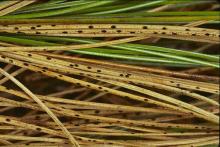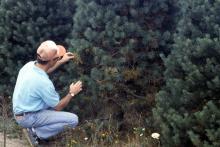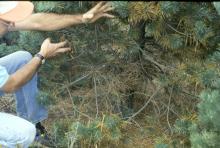Cause Lophodermium spp. Nineteen species, mostly host-specific, are in the Pacific Northwest. L. seditiosum is the main problem and occurs on Scots (Scotch) pine, infecting current-season needles, which may be killed by the next season. Wet weather and poor air circulation, which keep foliage wet, favor disease development. These fungi are variable enough that some viable fruit bodies are available for a low level of spore production all year long. L. pinastri and other species cause casting of 2- and 3-year-old Scots pine needles. L. baculiferum on ponderosa pine and L. nitens on white pine are commonly found in the forest and sometimes on ornamentals.
The black hysterothecia are conspicuous on fallen pine needles but are usually not an indication of an important disease problem. Less pathogenic Lophodermium species usually cause minimal injury to needles.
Symptoms On Scots pine, L. seditiosum forms yellow spots on infected needles. These may coalesce and become reddish-brown by April. Soon the entire needle becomes reddish brown and usually is cast, lodging in remaining foliage or on the ground. The blackish, football-shape fruiting bodies (hysterothecia, a type of apothecium) mature in late summer and disperse spores that invade the most recent foliage when autumn rains begin. The disease may stunt or kill seedlings or transplants.
L. baculiferum and L. nitens yellow foliage in mid- or late summer. Yellowed needles subsequently drop. The fungus fruits in dead foliage after casting or while still on the tree. The hysterothecia are football shape and black. When mature, they split down the middle to expose the spore layer. In favorably wet conditions, these fungi may cause widespread and noticeable symptoms on forest trees. They also are reported to damage forest nursery seedlings.
Can easily be confused with other needle cast diseases. Needle cast diseases are identified by microscopically examining fruiting bodies and spores. Needle casts can also be confused with annual (normal) fall needle drop. Most conifers shed some of their oldest needles in the fall. These old needles often turn yellow or brown before falling off.
Cultural control
- Provide good air circulation; do not crowd plants.
- Practice good weed control so lower needles are not kept moist for extended periods of time.
- For high-value trees, remove and destroy fallen needles that collect in branch crotches and on the ground.
Chemical control In British Columbia, apply at least three (3) monthly sprays between late July and late September to control the disease. In dense plantings and those with a history of needle cast, begin 2 weeks earlier and continue into October. Two-week intervals must be used in Michigan to get any control. These recommendations can be used as a guide for managing the disease in the PNW.
- Armada 50 WDG at 9 oz/100 gal water. Do not use a silicone-based surfactant. Not for nursery or greenhouse use. Group 3 + 11 fungicide. 12-hr reentry.
- Azoxystrobin products are registered. Group 11 fungicide. 4-hr reentry.
- Abound at 6 to 15.5 fl oz/A for Christmas tree use. Do not apply with silicone-based surfactants.
- Heritage at 3.2 to 8 oz/A plus a non-silicone-based wetter sticker. Registered for conifers including Christmas trees.
- Quadris at 6 to 15.5 fl oz/A for Christmas tree use.
- CuPRO 5000 at 3 to 5 lb/A. Group M1 fungicide. 48-hr reentry.
- Bravo Weather Stik at 2.75 to 5.5 pints/A. Group M5 fungicide. 12-hr reentry.
- Daconil Weather Stik at 2.75 to 5.5 pints/A. Do not use a spreader-sticker. Group M5 fungicide. 12-hr reentry.
- Dithane M45 at 2 to 4 lb/A or per 100 gal water plus a spreader-sticker. Registered for use on Christmas trees. Group M3 fungicide. 24-hr reentry.
- Echo 720 at 2.75 to 5.5 pints/A. Group M5 fungicide. 12-hr reentry.
- Mural at 3.5 oz/100 gal water. Registered for ornamentals grown in nursery, greenhouse, and landscapes. Group 7 + 11 fungicide. 12-hr reentry.
- Penncozeb 75 DF at 2 to 4 lb/A. Registered for use on Christmas trees. Group M3 fungicide. 24-hr reentry.
- Spectro 90 WDG at 1 to 2 lb/100 gal water. Registered for conifers grown in nursery, greenhouse or landscape. Group 1 + M5 fungicide. 12-hr reentry.
Reference Goheen, E.M., and Willhite, E.A. 2006. Field guide to the common diseases and insect pests of Oregon and Washington conifers. R6-NR-FID-PR-01-06. Portland, OR. USDA Forest Service, PNW Region.




